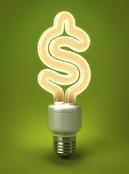Insp re
Lighting Services
CALL TO ORDER: (972) 979-9894
Interested in learning more about saving money?
Saving Money
Why make a change?
The common incandescent light bulb did it's job inexpensively, giving inventors little incentive to change the technology over the years. Then, as lighting designers became increasingly aware of the value of being energy efficient, they began to realize that maybe the common light bulb didn’t so work well. In fact, contrary to its name, the light bulb emitted more heat than light. According to the US Government’s Energy Star, program, 90 percent of the energy it consumes produces heat, not light.
Inspire Lighting Services © 2012
What's the difference, you say? The old-fashioned incandescent light bulb works just fine, illuminating my office, store or home. Why change? All the heat that's produced means 90 percent of the energy that goes into the light bulb dissipates as wasted energy. As a result, you are paying for energy that you will never use. Think of it this way, you buy a gallon of water, but you throw nine-tenths of the contents down the drain and only use what's left for drinking. That’s what it is like to use incandescent light bulbs.
Saving money with efficient lighting
Consumers pay for this wasted energy both directly and indirectly. It’s easy to see the impact of direct costs. A CFL (compact fluorescent light bulb), the most commonly used energy-efficient light at this point, creates about 75 percent less heat than a standard incandescent light bulb, and lasts about 10 times longer, according to Energy Star. CFLs cost more to buy, but cost less to operate, so they pay back their initial cost many times over. By removing one incandescent bulb and replacing it with one CFL, you save on average $69 over the product’s lifetime, based on an electric rate of 11.3 cents/kWh.
The cost savings also depends on the type of lighting system that's installed. According to the ECSC (Energy Cost Savings Council), energy-efficient lighting projects generate and average 45% ROI (return on investment), and the cost of the investment is recouped in savings in only 2.2 years.
Commercial businesses can expect to see substantial direct savings from cost efficient lighting, because depending on the type of operation, 20% to 50% of all electricity that's consumed is a result of lighting.


